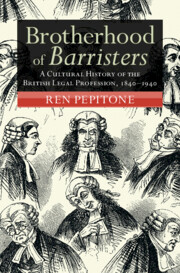Book contents
- Brotherhood of Barristers
- Modern British Histories
- Brotherhood of Barristers
- Copyright page
- Dedication
- Contents
- Figures
- Preface: A Primer on the Bar
- Acknowledgments
- 1 Introduction
- 2 The Metropolitan Inns
- 3 The Culture of the Bar
- 4 Gentlemanliness, Etiquette, and Discipline
- 5 Overseas Students
- 6 Women and the Bar
- Epilogue
- Bibliography
- Index
3 - The Culture of the Bar
Published online by Cambridge University Press: 11 April 2024
- Brotherhood of Barristers
- Modern British Histories
- Brotherhood of Barristers
- Copyright page
- Dedication
- Contents
- Figures
- Preface: A Primer on the Bar
- Acknowledgments
- 1 Introduction
- 2 The Metropolitan Inns
- 3 The Culture of the Bar
- 4 Gentlemanliness, Etiquette, and Discipline
- 5 Overseas Students
- 6 Women and the Bar
- Epilogue
- Bibliography
- Index
Summary
This chapter examines how, particularly in response to their growing middle-class population, the Inns of Court relied on their architectural spaces and social practices to ensure that all members of the bar embodied the ideal of the gentlemanly professional. In the absence of required classes, the societies stressed fraternization with older generations to inculcate new members with legal knowledge and the values appropriate to British barristers. The societies emphasized affective bonds and tried to cultivate fraternal relationships between their members. Yet in the mid-nineteenth century, the category of gentlemanliness was itself in flux, subject to divergent ideas of who could be a gentleman and how a gentleman should behave. Competing ideas of who belonged at the societies or what counted as gentlemanly behavior could result in unanticipated affective registers, including anger, indignation, and shame.
Keywords
- Type
- Chapter
- Information
- Brotherhood of BarristersA Cultural History of the British Legal Profession, 1840–1940, pp. 52 - 89Publisher: Cambridge University PressPrint publication year: 2024

